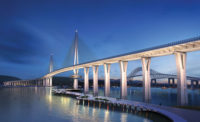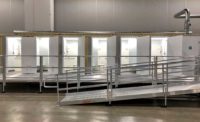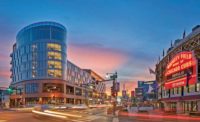2019 revenue topped $6 billion for the Midwest’s largest design firms, but the COVID-19 pandemic is likely to have a big impact on revenue going forward.
ENR Midwest’s list of Top Design Firms ranks 105 companies based on revenue across the 11-state region, and they once again demonstrate a remarkable breadth of specialties, including transportation, water supply, manufacturing, petroleum, telecommunications and health care.
The top 10 firms all retained the same rank as in the previous year, with AECOM, Burns & McDonnell and HDR taking the top three positions. The top 105 firms earned a record-breaking $6.14 billion in fiscal year 2019, an increase from the $5.78 billion reported the previous year. As in 2018, both AECOM and Burns & McDonnell were the only firms to top the $500-million revenue mark.
“Things have obviously changed in the last weeks, but last year was great for the city in terms of all these projects,” says Jon Lewis, co-manager of Northbrook, Ill.-based Wiss, Janney, Elstner Associates’ (WJE) Chicago office.
|
Related Link |
The events of the last several months will likely impact businesses in every industry. While most states have listed construction as an essential business during the coronavirus outbreak, stay-at-home orders prevail in every Midwest state. The waves of those orders are only now starting to be felt throughout the design firm industry, and it could be many months before the full impact on industry revenue is known.
Julie Beauvais, vice president at St. Paul, Minn.-based Kimley-Horn (No. 10 in 2019 revenue), says the company worked in phases in order to send 4,500 employees home to work remotely in a period of less than two weeks. “I keep thinking we’re fortunate to be in the industry we’re in as opposed to those severely affected,” Beauvais says.
Kimley-Horn made it to the ranks of the top 10 thanks to its focus on transportation. Since opening in the Twin Cities in 2002, the firm has been a mainstay in the metro area’s light rail transit system, working on such massive projects as the 11-mile Green Line, the 14.5-mile Green Line extension and the Blue Line extension. The Blue Line extension runs 14 miles from Minneapolis to Brooklyn Park, home of Target Corp.’s north campus and was 90% complete until recently being put on pause.
“We like to say we’re like a boutique firm with resources,” says Mark Bishop, senior vice president at Kimley-Horn. Bishop credited the firm’s success in the transportation area as being built on long-term relationships with cities that are expanding their transit systems. In the case of the recent Blue Line extension, he says, “it was a massive effort with us having a strong local team here in Minneapolis.”
While Kimley-Horn found success in transportation, WJE has found success in transforming existing structures. The firm (No. 41 on the list) took on large-scale design facade projects over the last year that included the Old Main Post Office in downtown Chicago and the Old Cook County Hospital.
WJE worked with Chicago-based design architect Skidmore, Owings & Merrill and general contractor Walsh on the hospital. The building was originally completed in 1914, but as the Illinois Medical District grew throughout the 1990s, it was eventually left vacant and closed in 2002. Graffiti and shuttered windows soon scarred its exterior. In 2018, the Civic Health Development Group initiated the plan to reestablish the 350,000-sq-ft former hospital as a multipurpose building containing retail, office and hotel space. Elizabeth Cassin, WJE Chicago co-manager, says the firm developed a new terra-cotta preservation strategy, restoring the original Beaux-Arts style masonry and wood-framed windows.
“It took about 4,000 pieces (of the terra cotta) as just part of getting it back to its original glory,” Cassin says. “It means so much to the city to bring it back.”
WJE’s challenge, as with many of its facade restoration and structural investigations, was fitting a square peg in a round hole.
“It’s inherently harder to make your design vision work within the confines of an existing building,” Lewis says. He pointed specifically to WJE’s work on the Old Post Office. “You have something designed for tons and tons of mail instead of [being] multifunctional. There are no existing drawings, so you’re trying to create something that’s not there. It’s one of the things that makes our industry so compelling.”
The post office building was originally designed by Graham, Anderson, Probst & White and completed in 1921. Twelve years later it expanded to a total size of 2.5 million sq ft. The U.S. Postal Service moved out of it in 1996, leaving the space empty for more than 20 years.
WJE was brought in to lead facade rehabilitation by 601W Cos. when a redevelopment plan for a transformation to offices finally got off the ground in 2016. WJE’s role soon expanded into roof replacement, window restoration and replacement, historic preservation consulting and fire protection consulting, among others tasks. The project was completed in 2019 at a total cost of $800 million.
Large-scale projects propelled firms throughout the Midwest to record-high revenue levels in 2019. But that was before the first months of 2020, when COVID-19 openly spread through the region and effectively shut down many businesses. In late March, ENR reported half of architecture firms surveyed recorded fewer new design projects than expected for that month. Nearly every firm in the top 105—and everyone in the top 10—has addressed the pandemic through working at home and other measures.
Kimley-Horn, like all firms affected by this new normal, hopes to be back to business as usual sooner rather than later. As the Midwest and the rest of the country eases back into a more structured work situation, questions abound as to what will change for the industry going forward.
“The question is ‘What’s going to happen next month?” Beauvais says. “What does it mean for the future? The working remotely trend, we’ll probably see more of it in this industry.”






Post a comment to this article
Report Abusive Comment